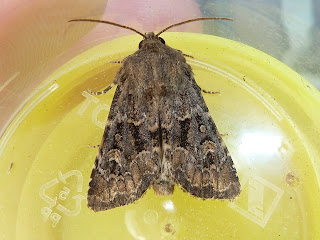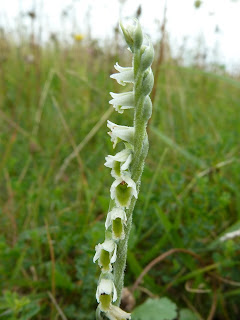A couple of birders were there and had seen my target birds already, an adult and juvenile spotted crake, and pointed me to where they had last seen them. Within 10 minutes of watching I had a brief view of one of them, the juvenile spotted crake, as it moved through some sedges before disappearing from view. The impression was of a small brown bird with pale speckling on its back and sides before it was lost to view. About an hour later I heard an unfamiliar alarm call and saw the juvenile spotted crake run through some sparse vegetation before disappearing from view again, this time I managed to see the yellow and red marked bill before it was lost from sight. And that was all I got for the 3 hours I stood and waited in the cold and wind and showers and I never saw the adult bird but it was worth it.
I have counted this as half a tick as a few years ago while visiting Radipole Lake in Dorset I had heard a spotted crake calling. It was a warm, humid overcast day around 4pm and it called regularly from vegetation right by the side of the footpath but I never caught a glimpse of it. Todays brief and a little disappointing views have now placed spotted crake firmly on my British life list.
Other birds of note were fulmars and gannets offshore, a flock of 20 curlew flying over with a single winter plumaged bar-tailed godwit amongst them and turnstone, ringed plover, sanderling and dunlin along the beach although they were very mobile due to disturbance from kite surfers and walkers.
As I left Penzance on the train at 1pm the sun had started to shine although it remained very windy. I got off the train at St Erth and walked down to the Hayle estuary, noticing a collection of birders at the road bridge crossing the head of the estuary and as I approached I could see 3 small waders feeding on the mud. And there were my second British lifers of the day, 3 pectoral sandpipers that gave ridiculously close views as they fed unconcernedly on the mud just below the bridge. I guess they have been blown over in the awful gales we had on Monday. What a time to have lost my camera! I had my old Canon Powershot camera with me and managed some half decent photos - I used to love my old Canon camera but using it today after my Panasonic Lumix it felt cumbersome, slow and clonky with quite limited optical capacity.
Three Pectoral Sandpipers!
Two Pectoral Sandpipers!
Pectoral Sandpiper - The bird on the right looks slightly larger
Pectoral Sandpiper - poor close up on my old Canon Powershot camera!
I watched the birds busily feeding for a while, they were very attractively marked birds and were like a cross between dunlin, purple sandpiper, common sandpiper and ruff. Pectoral sandpiper have been another of my bogey birds, having dipped them on quite a few occassions, so to see 3 together and at such close quarters was quite special.
Other birds seen were 20 eclipse plumaged teal, a summer plumaged black tailed godwit and a winter plumaged bar-tailed godwit, a juvenile shelduck and lots of gulls including a few adult lesser black backs.
And so I headed home on the train having had a great day bird watching, its very rare that I see a new bird so having seen 2 new birds was quite a feeling!












































